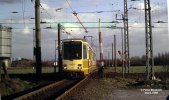Steve Manners
Registered
I live in Hull and I am making up a toy train set of the Beverley Road Stepney station area. I am using 45mm gauge track and working in "1/24 ish" scale. I plan to scratch build a tram and tramway to cross the railway at right angles using RC for the tramway. I would like to use RC and analogue track power for the railway. I have some thoughts on how to do it but wonder if anyone has already had a go at something similar? If you have I would welcome any thoughts you might have. Steve. M.





